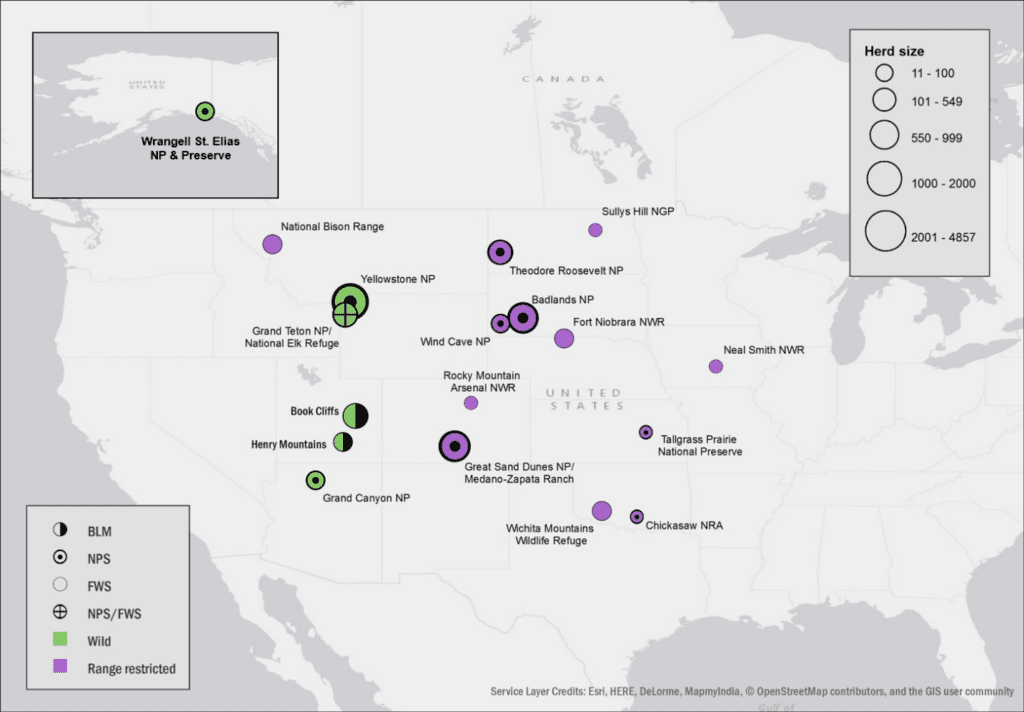Share this article
New bison conservation initiative focuses on genetic diversity
In the 17th and 18th century, North American plains bison (Bison bison bison) nearly went extinct due to unregulated and unsustainable harvest and habitat loss. Across the country today, some 30,000 bison are conserved by states, private groups and the Department of the Interior. The DOI supports about 11,000 plains bison that exist in 19 distinct herds on federal lands. However, some of those DOI bison herds could be in trouble again.
This time, the threat is not overexploitation but the loss of genetic diversity, according to a new bison report published by the National Park Service.
In the report that included a new population viability assessment, authors from NPS, U.S. Fish & Wildlife Service, International Union for the Conservation of Nature and Wildlife Conservation Society gathered genetic data from 16 Department of Interior herds and two Parks Canada bison herds to assess their existing genetic diversity and long-term viability.
They found that small bison populations are vulnerable to extinction from random catastrophic events. Loss of genetic diversity from genetic drift can also make it harder for those populations to adapt to changing environments, they found. And if current management continues and no efforts are made to increase gene flow between herds, the report says that all herds will see reduced genetic diversity over the next two centuries.
The new assessment came with DOI’s May 7th announcement of the 2020 Bison Conservation Initiative. The initiative provides a guide to the next 10 years of bison conservation on federal public lands. It focuses on maintaining genetic diversity. The Initiative also reaffirms visions from the 2008 Bison Conservation Initiative, which aimed to support ecological and cultural restoration of bison.
The 2020 initiative says that the population viability assessment will inform development of a DOI bison Metapopulation Management Strategy. This strategy will use translocations of bison between the different federal bison herds to allow for gene flow and create an interconnected metapopulation rather than maintaining isolated, distinct populations. Introducing new genes into isolated herds will prevent loss of genetic diversity, which could threaten herds’ future ability to adapt to changing environments. Translocations are also part of the strategy for managing growing bison populations in limited habitats.

A map of the 19 DOI bison herds shows the considerable variation in herd sizes.
Credit: Department of the Interior
The assessment says that individual herds have different management needs to maintain genetic diversity and will need herd-specific translocation strategies. Though one uniform strategy will not be sufficient, the assessment does say that for most of the herd herds, translocation of two to three animals every five to 10 years can conserve genetic diversity. Most DOI bison herds have around 300 to 500 bison, but herd sizes range from almost 5,000 animals at Yellowstone National Park to just 10 bison on the Chickasaw National Recreation Area in Oklahoma. Smaller herds like Chickasaw will require more incoming bison translocations than larger herds.
Along with the Metapopulation Management Strategy, the initiative has four other major goals. The first goal is to conserve bison as healthy wildlife by managing for diseases that affect populations while also aiming to maintain natural selection and breeding competition. Part of the disease management strategy is ensuring that any translocated bison is free of the brucellosis bacterial infection. Another goal is to support shared stewardship of bison between federal, state, tribal and private partners. The initiative highlights that such a multi-stakeholder approach is crucial to achieve another of its goals: large-scale bison conservation where bison retain their ecological function as ecosystem engineers. The Initiative’ final goal is to restore cultural connections to bison, especially among Native Americans.
In addition to its main goals, the initiative also identified other key actions. These include developing and adopting low stress bison capture and handling techniques during translocations. The DOI also wants to continue donating bison to Native American tribes and encouraging states to propose requests for new bison herds that will be state-managed, wild and huntable. Eleven states already manage their own bison herds, with several allowing bison hunting.
In 2020, wildlifers should watch for updates on the development of the Metapopulation Management Strategy. This year, the DOI will also transfer bison from Rocky Mountain Arsenal National Wildlife Refuge in Colorado to Theodore Roosevelt National Park in North Dakota. DOI will also donate bison to establish a herd on the Rosebud Sioux Reservation in South Dakota.
Header Image: The Department of the Interior must translocate bison between its herds to prevent loss of genetic diversity. Credit: Yellowstone National Park








